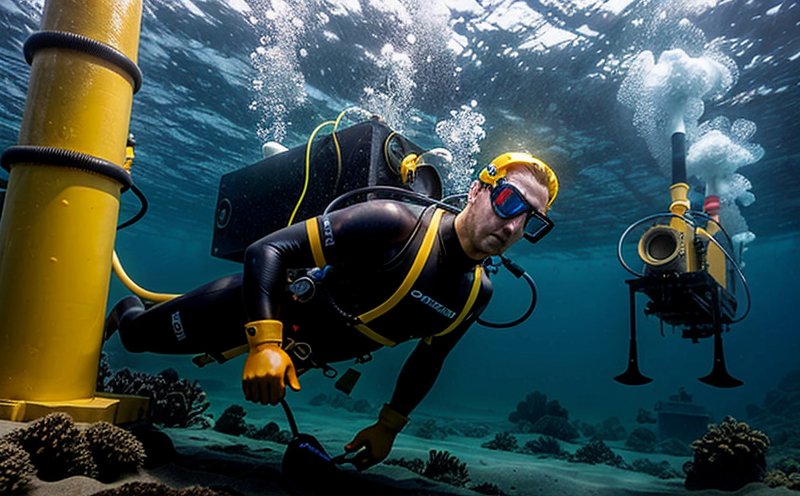ISO 3452 Liquid Penetrant Testing of Subsea Welds
The ISO 3452 standard is widely recognized in the marine and shipbuilding sectors for ensuring the integrity and reliability of subsea welds. This service focuses on the precise application of liquid penetrant testing (LPT) to detect surface-breaking defects in critical components such as pipelines, hull structures, and other underwater equipment. The process involves applying a penetrant dye to the weld surface, allowing it to seep into any open flaws, then drying and removing excess dye before applying developer. The developer highlights the flaw indications, which are subsequently analyzed for compliance with specified acceptance criteria.
The ISO 3452 LPT is particularly important in the subsea environment where even minute cracks or imperfections can lead to catastrophic failures due to the harsh operating conditions, including high pressure and temperature differentials. The testing process ensures that welds meet stringent quality standards set by international regulations like IEC 61087-3 for underwater cables.
Our team of experts uses advanced equipment tailored for subsea applications, ensuring accurate and reliable test results. Specimen preparation involves thorough cleaning to remove contaminants that could interfere with the testing process. The use of appropriate penetrants and developers is crucial to achieving optimal flaw detection. Reporting includes detailed documentation of each step in the process, along with clear images and descriptions of any defects found.
The ISO 3452 standard ensures that all test procedures are consistent and repeatable across different locations and operators. This consistency is vital for maintaining quality throughout the supply chain and ensuring compliance with international standards such as the ISO itself and other relevant industry guidelines like ASTM E1876-19.
Our service not only adheres to these standards but also provides additional insights into the testing process, helping our clients understand the importance of each step in the procedure. By leveraging this knowledge, we assist them in making informed decisions regarding quality assurance and compliance.
In summary, ISO 3452 LPT is a critical component of the marine and shipbuilding industry's efforts to ensure reliability and safety in subsea equipment. The service provided here ensures that every weld undergoes rigorous testing to meet the highest standards, thereby contributing significantly to overall operational safety and efficiency.
Industry Applications
Offshore oil platforms where integrity of subsea pipelines is critical for preventing leaks that could lead to environmental disasters.
Submarine cable installations requiring thorough inspection of joints and connections to ensure they can withstand deep-sea pressures.
Marine structures like buoys, moorings, and other floating devices where structural integrity must be guaranteed against corrosion and mechanical stress.
Naval vessels undergoing maintenance or repair processes that demand verification of weld quality before returning to service.
The application of ISO 3452 LPT is not limited to these areas but extends to any scenario where the integrity of subsea components is paramount. This includes research and development phases, where potential flaws can be identified early in the design process.
International Acceptance and Recognition
The ISO 3452 standard is recognized globally for its stringent requirements on subsea weld testing. It has been adopted by numerous international standards organizations, including IEC and ASTM.
Countries such as the USA, UK, Norway, and Singapore adhere to this standard due to its reliability in ensuring product quality and safety.
Adherence to ISO 3452 not only ensures compliance with international regulations but also enhances a company's reputation within the industry. This is particularly true for multinational corporations that operate across various jurisdictions where consistent standards are essential.
Environmental and Sustainability Contributions
The use of ISO 3452 LPT contributes positively to environmental sustainability by ensuring that subsea equipment operates reliably without the risk of failures leading to leaks or other incidents. This reduces the likelihood of oil spills, methane releases, or other harmful emissions into marine environments.
By maintaining high standards in weld quality through rigorous testing, we help our clients reduce waste and avoid costly repairs due to premature failure. The process also promotes a culture of continuous improvement in manufacturing processes, which can lead to more efficient use of resources over time.
In summary, ISO 3452 LPT plays an essential role in supporting the sustainable practices of marine and shipbuilding industries by ensuring that every component is fit for purpose and capable of enduring harsh subsea conditions without compromising environmental integrity.





